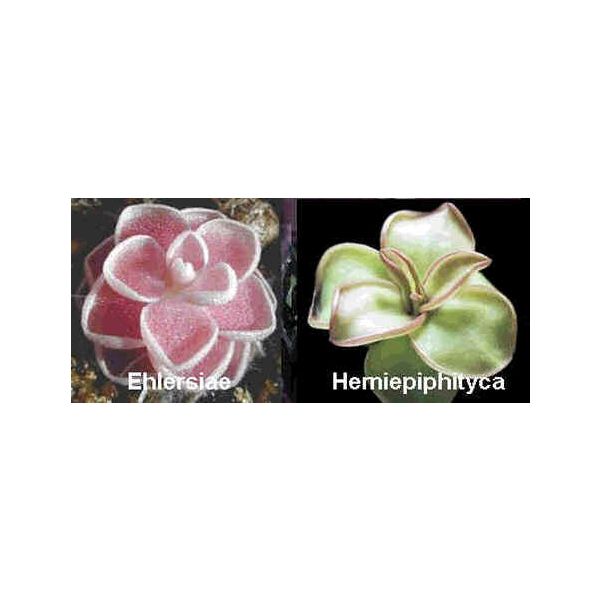Pinguicula Seeds Mix Mexican Pinguicula Seeds (Ehlersiae, Hemiepiphytica, Hemiepiphytica x Orchidioides)
Pinguicula Seeds Mix Mexican Pinguicula Seeds (Ehlersiae, Hemiepiphytica, Hemiepiphytica x Orchidioides)
The carnivorous leaves are produced in Spring and during all Summer. The flowering occurs from Summer rosette.

Delivery
All orders shipped with UPS Express.
Always free shipping for orders over US $250.
All orders are shipped with a UPS tracking number.
Returns
Items returned within 14 days of their original shipment date in same as new condition will be eligible for a full refund or store credit.
Refunds will be charged back to the original form of payment used for purchase.
Customer is responsible for shipping charges when making returns and shipping/handling fees of original purchase is non-refundable.
All sale items are final purchases.
Help
Give us a shout if you have any other questions and/or concerns.
Email: contact@domain.com
Phone: +1 (23) 456 789
Availability: Out of stock
SKU
Pinguicula (Mélange de Pinguicula Mexicaines)
This is a mix of the most beautiful Mexican Pinguicula I can get. It includes Pinguicula ehlersiae, Pinguicula hemiepiphytica, Pinguicula emarginata and Pinguicula hemiepiphytica x orchidioides. They come from montains in temperate climats.
The life cycle observed in culture for Mexican Pinguicula consists of two seasons, one wet and the other dry. The plant forms different leaf rosettes according to the season. During the resting months in Winter, the smallrosette is composed of numerous non-carnivorous leaves. The carnivorous leaves are produced in Spring and during all Summer. The flowering occurs from Summer rosette.
Mexican Butterworts are from the temperate climates and require a dormancy period. During dormancy the plant die back to a resting bud known as a hibernacula. Temperate Butterworts not only reproduce by seed, but also by gemmae. These gemmae, brood bodies, form around the base of the hibernacula. They look like miniature resting buds. They break of from the hibernacula very easily and are scattered around, assisting on the further propagation of the species.
The flat leaves of the Butterwort are covered in thousands of minute hairs each topped with a little glob of sticky glue. This glistens in the sun, sometimes having a rainbow effect, and this is thought to attract small flies such as gnats and fruit flies. Once caught the prey will rarely be able to come unstuck, and struggling just makes things worse. Almost immediately glands on the leaf secrete digestive juices to soften the prey. So much is produced that this can happen in a few hours. The nutrient rich fluid is then re-absorbed. Sometime the edges of the leaf curl inwards, possibly to prevent these juices escaping.
Hardiness zone 8 (-10øC/15øF) in Winter. The plants need cold Winter temperatures to survive. Habitats may vary from semi-shady to full sun exposition. Optimal Summer growing conditions are good air humidity, cool temperature and UV lights. If the Summer growing conditions are not optimal, the plants will form very weak hibernacula which easily rot. During growth period, procure a day temperatures of about 25øC and night temperatures around 20øC. During resting period days and nights should be over freezing point. Keep above 7øC in Winter.
Best grown outdoors as a container or potted plant. Because of their specific soil requirement, avoid planting them in the ground. Excellent for the deck or patio. Peat moss/sand or peat moss/vermiculite mixes or even pure vermiculite works well.
Use rain water poured on the top of the pot taking care not to wet the rosette. When those Pinguicula begin to produce their non-carnivorous leaves, from October to April, it is important to let the media drying completely but with an atmospheric humidity of about 80%. You can do that by putting a saucer full of water under the pot, evaporation will do the rest. Inversely, when the plant begins to produce in early Spring its carnivorous leaves, you have to progressively start watering again the pot. Let the media drying slightly between two watering.
| Common name | Mexican Butterwort |
|---|---|
| Species | Pinguicula |
| Germination | Those seeds require 2-3 months cold stratification before sowing, directly on the surface of your moist but not soaked soil mix. Once it's time to take the seeds out of cold stratification, cover the top of the pot with clear plastic so the humidity will remain high, place them in an area with real nice strong light and keep the temperature around 20øC/68øF, 24øC/75øF. When you see some tiny plants starting to sprout, slowly open the top of the pot, a little each day, so that the new seedlings don't go into shock from the humidity being lowered too quickly. After cold stratification, germination can take several months. It can be more depending on their degree of unbroken dormancy, don't give up. |
| Scarification / Stratification | It creates a cold and moist environment for the seeds. This will break their dormancy. Place the seeds on top of a prepared soil mix. The pot is then placed into a ziplock bag with approximately an inch of water on the bottom of the bag. Close the bag shut and place it into the salad crisper compartment of your refrigerator. Make sure to check the seeds often. If fungus or mold appears treat it with a fungicide. |
| Price View | Price Range |

